Photographing gorillas is very exciting because they are one of our closest relatives. Even though many question whether gorilla trekking is ethical or not, observing them in the wild should be undertaken by everyone at some point in their lives. Gorilla Tourism is the only reliable way to generate funds for their protection/conservation. Leave them alone in the wild and they could be prone to poaching, pet trading and encroachment on their natural habitat. Gorilla tracking involves hiking deep into Africa’s jungles in search of the primates. Finding them is 100% guaranteed because a group of advance trackers are sent earlier to find their exact location. The Guide and Rangers moving with tourists will be in constant communication with the advance trackers in order to know the best route to use. Once you find the gorillas, the Rangers will study their mood before allowing tourists to start taking photos and videos.
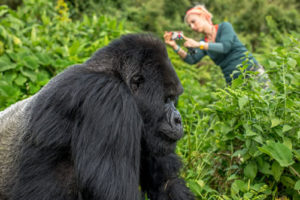 Getting good images of the primates is what every tourist hopes for whenever they book a gorilla tour. Gorillas are one of our closest relatives. Only 1000 mountain gorillas still roam the forests of Bwindi, Mgahinga, Virunga and the Volcanoes National Park. It is therefore important to take great photos of the primates so that you can share them with your friends, family and the world through the various social media pages. If you are a professional photographer or part of a film crew, you might want to read our article about gorilla filming and also the one on using drones during gorilla trekking.
Getting good images of the primates is what every tourist hopes for whenever they book a gorilla tour. Gorillas are one of our closest relatives. Only 1000 mountain gorillas still roam the forests of Bwindi, Mgahinga, Virunga and the Volcanoes National Park. It is therefore important to take great photos of the primates so that you can share them with your friends, family and the world through the various social media pages. If you are a professional photographer or part of a film crew, you might want to read our article about gorilla filming and also the one on using drones during gorilla trekking.
Photographing gorillas in Uganda and Rwanda
In order to photograph gorillas, you need to first locate them. We hope you would have selected a suitable and exciting gorilla group to track. There are about 17 habituated gorilla groups in Uganda, 10 in Rwanda and 8 in Congo. Each gorilla group is special and has a different composition of individuals. Some have more individual gorillas, more silverbacks, more breastfeeding mothers and more infants. You need to let your tour company know about your preferences so that they can arrange for you to track a gorilla group of your choice. It is more difficult to track a group of your choice these days because gorilla groups are now allocated based on age and overall fitness of trackers. However, influential tour companies can still ensure that you get a larger family or an easier trek.
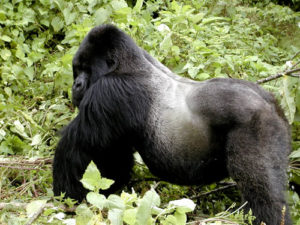 Taking photos of gorillas can be easy, complicated or even frustrating depending on the location of the group and overall terrain. The tropical rains, thick forests and resulting low light conditions may also present a challenge for inexperienced photographers. It is also important to note that gorillas (especially the adults) are generally shy primates. Because they don’t maintain direct eye contact for long, improvisation and a good camera will be important for you want to get a variety of facial expressions. Whereas the objective of most tourists is to produce sharp images that expose the gorillas in every angle, it is important to also take time to observe and enjoy the incredible experience.
Taking photos of gorillas can be easy, complicated or even frustrating depending on the location of the group and overall terrain. The tropical rains, thick forests and resulting low light conditions may also present a challenge for inexperienced photographers. It is also important to note that gorillas (especially the adults) are generally shy primates. Because they don’t maintain direct eye contact for long, improvisation and a good camera will be important for you want to get a variety of facial expressions. Whereas the objective of most tourists is to produce sharp images that expose the gorillas in every angle, it is important to also take time to observe and enjoy the incredible experience.
Note: Never use flash photos when taking photos of gorillas as you will also find out from our articles covering the gorilla trekking rules and gorilla charging. Gorillas are generally uncomfortable with flush cameras and could get irritated or even charge if you are unlucky.
Gorilla Photography Tips in Congo, Rwanda and Uganda
Here are some things to consider when planning a gorilla photography safari: –
Terrain and Vegetation: Gorillas live in dense forests and sometime mountain slopes. As you attempt to photograph a family, you may have a lot of distractions like leaves, tree brunches and vines. Some mountain gorilla groups live in areas with high altitude. This is particularly true if you are planning to do 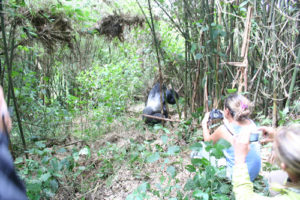 gorilla trekking in the Volcanoes National Park of Rwanda and Mgahinga National Park in Uganda. You need to position yourself well so that you have fewer distractions.
gorilla trekking in the Volcanoes National Park of Rwanda and Mgahinga National Park in Uganda. You need to position yourself well so that you have fewer distractions.
Gear and protective equipment: Given the rough conditions in the jungle, it is important to go prepared. Tropical forests receive rain even during the dry season. You should therefore ensure that you have protection for your cameras and related equipment, a rain-proof bag will come in handy and help protect your cameras from any damages. Also remember to travel with enough memory cards and batteries for the camera.
Telephoto Zoom Lens: You cannot predict the circumstances under which you will find the primates. Gorillas sometimes move from one place to another as they foliage. A camera with telephoto lens can help you photograph gorillas even when they are far away. Lenses that are 200mm to 300mm are good enough for close distance photography but we recommend those of a 400mm range to get perfect shots regardless of the distance between you and the primates. If you want to take photos that are out of the ordinary or different from the usual, you might want to consider X-factor Lenses. X-factor lenses are popular with professional photographers who aim for stunning images to sell or share online.
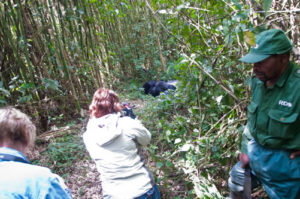 Consider Shooting on burst mode: This is especially important if you want to capture facial expression in adult gorillas. The facial expression in a gorilla changes very quickly and in seconds. In order to get the best shots, you will need to take several shots at once. The camera needs to be set up correctly to get perfect shots. It is important to remember that mountain gorillas are large creatures with black fur. The green environment and dark coat can confuse light coming out of some cameras if not well set. Set your camera correctly to avoid overexposure.
Consider Shooting on burst mode: This is especially important if you want to capture facial expression in adult gorillas. The facial expression in a gorilla changes very quickly and in seconds. In order to get the best shots, you will need to take several shots at once. The camera needs to be set up correctly to get perfect shots. It is important to remember that mountain gorillas are large creatures with black fur. The green environment and dark coat can confuse light coming out of some cameras if not well set. Set your camera correctly to avoid overexposure.
Go with a second camera: This will come in handy in case the first one fails to work for some reason. Ensure that the second camera is of a different type so that you have two different lenses with different final products for comparison.
Camera Weight: If possible, travel with a light weight camera. Gorilla tracking can take between 2 to 6 hours to complete depending on the location of the gorilla family you would be following. Do not worry if you have very heavy cameras. All the gorilla parks have porters who help tourists carry any heavy bags and equipment at a small fee of about $15.
Other things to consider when planning for a gorilla photography safari
While taking photos of mountain gorillas, it is always important to follow instructions from park Guides. Remember the gorilla trekking rules such as keeping a distance of at least 7 meters, avoiding prolonged direct eye contact and standing taller than the primates when they get close to you.
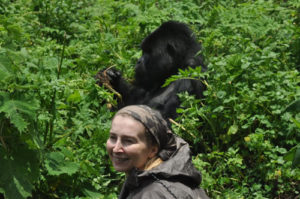 Remember that you will have only one hour in which to take photos of the gorillas if you opt for the standard gorilla trekking. If you want more time with the primates, you will need to go for the more expensive gorilla habituation experience were travelers can observe the primates for 4 hours. The gorilla habituation experience is only possible in Bwindi Impenetrable National Park of Uganda. The gorilla habituation experience in Bwindi has one downfall. You would be tracking gorilla groups that are not fully habituated. Getting too close may be more difficult without alerting the primates.
Remember that you will have only one hour in which to take photos of the gorillas if you opt for the standard gorilla trekking. If you want more time with the primates, you will need to go for the more expensive gorilla habituation experience were travelers can observe the primates for 4 hours. The gorilla habituation experience is only possible in Bwindi Impenetrable National Park of Uganda. The gorilla habituation experience in Bwindi has one downfall. You would be tracking gorilla groups that are not fully habituated. Getting too close may be more difficult without alerting the primates.
Mountain gorillas are very gentle primates and easier to photograph than other large primates. They are not as mobile as chimps and tend to stay in one place for a while as they forage on the forest flows. Habituated mountain gorillas will let you get closer to them than most primates. Despite this, you need 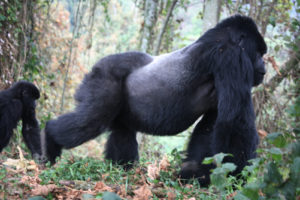 to maintain a distance of about 7 meters away from the nearest gorilla. This can become very difficult to implement once in the presence of the gorillas. They may come close to you making it difficult to keep away.
to maintain a distance of about 7 meters away from the nearest gorilla. This can become very difficult to implement once in the presence of the gorillas. They may come close to you making it difficult to keep away.
Don’t forget to pack a raincoat and sturdy hiking boots to deal with the unpredictable terrain. Remember that you will be searching for the primates in dense rain-forest. If you can, travel during the dry seasons. The dry seasons fall between December to March and June to August. These are peak seasons for travel in East and Central Africa. You need to book your gorilla tour as early as possible because it’s around this time that most tourists go for safaris in Africa.
